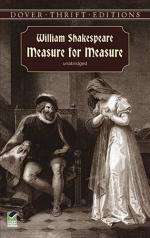|
This section contains 612 words (approx. 2 pages at 400 words per page) |

|
Measure for Measure Summary & Study Guide Description
Measure for Measure Summary & Study Guide includes comprehensive information and analysis to help you understand the book. This study guide contains the following sections:
This detailed literature summary also contains Further Study and a Free Quiz on Measure for Measure by William Shakespeare.
The earliest authoritative text available for Measure for Measure was published in the First Folio edition of Shakespeare's plays dated 1623. Today, most critics accept this version of the playas a transcription of Shakespeare's "foul papers," that is, an uncorrected manuscript written in the playwright's own hand. This theory is based on the presence in the text of anomalies often found in uncorrected manuscripts, such as sparse stage directions, omitted and transposed words, and mislineations. The first recorded performance of Measure for Measure was on December 26, 1604, when a play entitled "Mesur for Mesur" by "Shaxberd" was performed at Whitehall before King James I and his court by "his Maiesties players," the troupe with which Shakespeare was associated from early 1603 until his retirement
Two works have traditionally been regarded as the Primary sources of Measure for Measure: a novella in a collection of tales entitled Hecatommithi (1565) by Giovanni Batista Giraldi (known as Cinthio) and George Whetstone's two-part play, The Right Excellent and Famous Historye of Promos and Cassandra (1578), which was based on Cinthio's novella. However, several critics have noticed significant parallels between Measure for Measure and Epitia (1583), a drama adapted by Cinthio from his novella. These discoveries have led to the generally accepted theory that Shakespeare derived the main aspects of hIS plot from both of Cinthio's works and used the structure of Whetstone's drama to organize the actIOn, characterization, and themes of Measure for Measure According to this hypothesis, Shakespeare drew upon the Hecatommithi for the Duke's magnanimous nature, hIs deputation of Angelo, Isabella's intellectual character and her refusal to accept Angelo's proposition, and the Duke's attraction to Isabella, in Epitia, Shakespeare found the conflict between Justice and mercy and expanded It into a central theme in Measure for Measure. Finally, Shakespeare incorporated into Measure for Measure certain alterations of Cinthio's Hecatommithi which Whetstone used in Promos and Cassandra, such as the inclusion of a comic subplot. Measure for Measure has fascinated and perplexed audiences and Critics alike for centuries. Critical assessments have ranged from profound disappointment in the play's lack of consistency to assertions that Measure for Measure ranks as one of Shakespeare's greatest achievements. Scholars have in fact disagreed on virtually every aspect of the play, including its central themes and artistic unity as well as Its style, genre, and characterization. Principal topics of debate have included the characterizations of the Duke, Isabella, and Angelo. Scholars have for example been divided over whether the Duke is manipulative or wise; whether Isabella is rigidly moralistic or saintly and compassionate; and whether Angelo is incomprehensibly split into two separate personalities-one respectable and the other villainous.
Recent criticism has focused on the play's effectiveness at dealing with the themes of Justice versus mercy, and have argued over whether the play functions as an allegory for Christian charity versus the letter of the law Another source of scholarly speculation has been Isabella's silence in response to the Duke's marriage proposal critics have argued over whether her muteness indicates acceptance or rejection of his offer, and both critics and stage directors have suggested a variety of ways of dramatizing Isabella's reaction. Finally, critics continue to debate over the genre of Measure for Measure. While early commentators described the play as a comedy, owing to the fact that it ends in a series of betrothals and marriages, others have called It a tragicomedy that is neatly split into a tragic first half and a comic second half. Today, most Critics agree that Measure for Measure has earned its designation as a "problem play"-both because It leaves us with moral Issues which remain ambiguous to the end, and because It refuses to be neatly classified.
Read more from the Study Guide
|
This section contains 612 words (approx. 2 pages at 400 words per page) |

|



